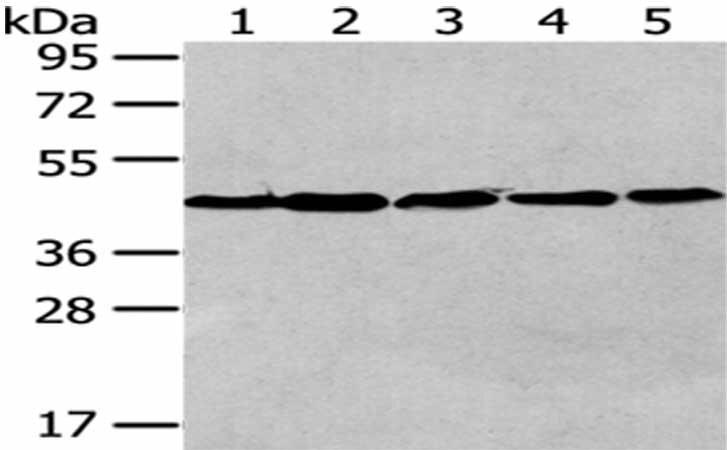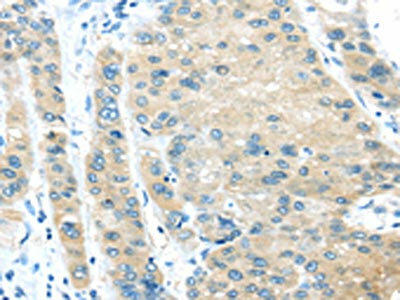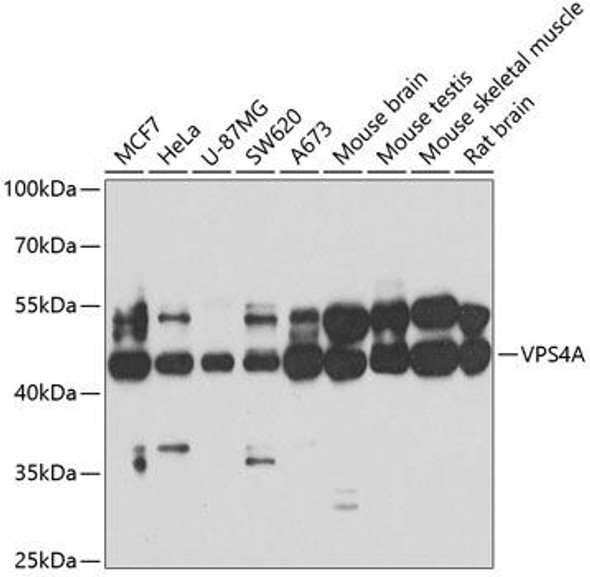Description
VPS4A Antibody (PACO20862)
The VPS4A Polyclonal Antibody (PAC020862) is a valuable tool for researchers studying VPS4A, a protein involved in the endosomal sorting complex required for transport (ESCRT) pathway. This antibody, produced in rabbits, has high specificity for human samples and has been validated for use in Western blot applications. By binding to the VPS4A protein, this antibody allows for the detection and analysis of VPS4A in various cell types, making it an essential tool for studies in cell biology and molecular biology.VPS4A is a key player in the ESCRT pathway, which is responsible for the sorting and trafficking of proteins within the endosomal system.
Dysregulation of this pathway has been implicated in various diseases, including cancer, neurodegenerative disorders, and viral infections. By understanding the function of VPS4A, researchers can gain valuable insights into these disease processes and potentially identify new therapeutic targets.Overall, the VPS4A Polyclonal Antibody is a reliable and specific tool for researchers interested in studying the ESCRT pathway and its role in disease pathogenesis. Its versatility and high reactivity make it a valuable addition to any research laboratory focused on cell trafficking and protein sorting mechanisms.
| Antibody Name: | VPS4A Antibody (PACO20862) |
| Antibody SKU: | PACO20862 |
| Size: | 50ul |
| Host Species: | Rabbit |
| Tested Applications: | ELISA, WB, IHC |
| Recommended Dilutions: | ELISA:1:2000-1:5000, WB:1:500-1:2000, IHC:1:25-1:100 |
| Species Reactivity: | Human, Mouse, Rat |
| Immunogen: | Synthetic peptide of human VPS4A |
| Form: | Liquid |
| Storage Buffer: | -20°C, pH7.4 PBS, 0.05% NaN3, 40% Glycerol |
| Purification Method: | Antigen affinity purification |
| Clonality: | Polyclonal |
| Isotype: | IgG |
| Conjugate: | Non-conjugated |
 | The image on the left is immunohistochemistry of paraffin-embedded Human thyroid cancer tissue using PACO20862(VPS4A Antibody) at dilution 1/25, on the right is treated with synthetic peptide. (Original magnification: x200). |
 | Gel: 8%SDS-PAGE,Lysate: 40 µg,Lane 1-5: Human liver cancer tissue, 293T cells, A172 cells, Hela cells, MCF7 cells,Primary antibody: PACO20862(VPS4A Antibody) at dilution 1/200 dilution,Secondary antibody: Goat anti rabbit IgG at 1/8000 dilution,Exposure time: 1 minute. |
 | The image on the left is immunohistochemistry of paraffin-embedded Human liver cancer tissue using PACO20862(VPS4A Antibody) at dilution 1/25, on the right is treated with synthetic peptide. (Original magnification: x200). |
| Background: | The protein encoded by this gene is a member of the AAA protein family (ATPases associated with diverse cellular activities), and is the homolog of the yeast Vps4 protein. In humans, two paralogs of the yeast protein have been identified. The former share a high degree of aa sequence similarity with each other, and also with yeast Vps4 and mouse Skd1 proteins. The mouse Skd1 (suppressor of K+ transport defect 1) has been shown to be really an yeast Vps4 ortholog. Functional studies indicate that both human paralogs associate with the endosomal compartments, and are involved in intracellular protein trafficking, similar to Vps4 protein in yeast. The gene encoding this paralog has been mapped to chromosome 16; the gene for the other resides on chromosome 18. |
| Synonyms: | vacuolar protein sorting 4 homolog A (S. cerevisiae) |
| UniProt Protein Function: | VPS4A: Involved in late steps of the endosomal multivesicular bodies (MVB) pathway. Recognizes membrane-associated ESCRT-III assemblies and catalyzes their disassembly, possibly in combination with membrane fission. Redistributes the ESCRT-III components to the cytoplasm for further rounds of MVB sorting. MVBs contain intraluminal vesicles (ILVs) that are generated by invagination and scission from the limiting membrane of the endosome and mostly are delivered to lysosomes enabling degradation of membrane proteins, such as stimulated growth factor receptors, lysosomal enzymes and lipids. In conjunction with the ESCRT machinery also appears to function in topologically equivalent membrane fission events, such as the terminal stages of cytokinesis and enveloped virus budding (HIV-1 and other lentiviruses). Involved in cytokinesis. Belongs to the AAA ATPase family. |
| UniProt Protein Details: | Protein type:EC 3.6.4.6; Vesicle Chromosomal Location of Human Ortholog: 16q22.1 Cellular Component: spindle pole; centrosome; late endosome membrane; perinuclear region of cytoplasm; cytoplasm; midbody; cytosol; nucleus Molecular Function:protein C-terminus binding; protein domain specific binding; protein binding; ATPase activity, coupled; microtubule-severing ATPase activity; ATP binding Biological Process: ubiquitin-dependent protein catabolic process via the multivesicular body pathway; cell separation during cytokinesis; viral reproduction; cytokinesis; viral infectious cycle; endosome transport; mitotic metaphase plate congression; negative regulation of cytokinesis; cytoplasmic microtubule organization and biogenesis; vesicle-mediated transport; protein transport; abscission; nuclear organization and biogenesis; vacuole organization and biogenesis |
| NCBI Summary: | The protein encoded by this gene is a member of the AAA protein family (ATPases associated with diverse cellular activities), and is the homolog of the yeast Vps4 protein. In humans, two paralogs of the yeast protein have been identified. The former share a high degree of aa sequence similarity with each other, and also with yeast Vps4 and mouse Skd1 proteins. The mouse Skd1 (suppressor of K+ transport defect 1) has been shown to be really an yeast Vps4 ortholog. Functional studies indicate that both human paralogs associate with the endosomal compartments, and are involved in intracellular protein trafficking, similar to Vps4 protein in yeast. The gene encoding this paralog has been mapped to chromosome 16; the gene for the other resides on chromosome 18. [provided by RefSeq, Jul 2008] |
| UniProt Code: | Q9UN37 |
| NCBI GenInfo Identifier: | 62511240 |
| NCBI Gene ID: | 27183 |
| NCBI Accession: | Q9UN37.1 |
| UniProt Secondary Accession: | Q9UN37,Q793F9, Q8VEJ9, |
| UniProt Related Accession: | Q9UN37 |
| Molecular Weight: | 437 |
| NCBI Full Name: | Vacuolar protein sorting-associated protein 4A |
| NCBI Synonym Full Names: | vacuolar protein sorting 4 homolog A (S. cerevisiae) |
| NCBI Official Symbol: | VPS4A |
| NCBI Official Synonym Symbols: | SKD1; SKD2; VPS4; SKD1A; VPS4-1 |
| NCBI Protein Information: | vacuolar protein sorting-associated protein 4A; VPS4A; hVPS4; SKD1-homolog; vacuolar sorting protein 4; vacuolar protein sorting factor 4A |
| UniProt Protein Name: | Vacuolar protein sorting-associated protein 4A |
| UniProt Synonym Protein Names: | Protein SKD2; VPS4-1; hVPS4 |
| Protein Family: | Vacuolar protein sorting-associated protein |
| UniProt Gene Name: | VPS4A |
| UniProt Entry Name: | VPS4A_HUMAN |















